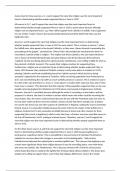Assess how far these sources a, b, c and d support the view that religion was the most important
factor in determining whether people supported Mary or Jane in 1553?
All sources A, B, C, and D support the view that religion was the most important factor in
determining whether people supported Mary or Jane in 1553 to some extent because although
religion was an important factor, e.g. Mary rallied support from Catholics in Suffolk, many supported
her out of their ‘malice’ (Source A) towards Northumberland and their belief that Mary was the
legitimate ruler.
Sources C and D support the view that religion was the most important factor in determining
whether people supported Mary or Jane in 1553 to some extent. This is a shown in source C, where
the Suffolk men, who appear to be devout Catholics, as they were ‘always forward in prompting the
proceedings of the gospel,’ ‘promised her’ (Mary) ‘their aid provided she would promise them no
innovations could be made to religion.’ This implies that these Catholics, who also hated whatever
was in favour of Northumberland (Lady Jane grey being on the throne) because they had been
‘subdued’ by him (not being allowed to openly practise Catholicism), were willing to fight for Mary as
they desired a Catholic monarch. This reveals their religious motives for supporting Mary.
Furthermore, religion was an important factor in determining whether people supported Mary or
James 1553 because Mary reinforced Catholic customs in only some places in London (in 1553),
pleasing Catholics and firmly establishing herself as Catholic monarch which led to her being
accepted/ supported by the majority of Catholics, while not stirring opposition from Protestants as
she’s not overwhelming the city with too much Catholic presence/ customs. This is evident in source
D as the writer says that there is a mass in ‘some places’ in London after Lady Jane Grey asks if ‘they
have mass in London.’ This illustrates that the majority of the population supported Mary as she was
steadily returning England to Catholicism (in 1553) where most people in England were Catholic.
However, Source D is unreliable because although the writer is recording a conversation, and the
purpose is to inform, the date it’s written is unclear which means the writer could be recording this
inaccurately. Also, the writer could be biased because he was with the Protestant Lady Jane Grey so
he may have made out there were less Catholic customs (mass) than there actually was, to please
her and he also leaves out any other aspects of Catholicism in England, making the source somewhat
limited. Source C is somewhat reliable because the writer informs the reader of the Suffolk men’s
religious motives but it’s also somewhat unreliable because it leaves out other reasons for them
supporting Mary (such as legitimacy) which is why John Foxe, a Puritan, may have used this source in
his Acts of Monuments, Vol VI, making it a biased source. Therefore, sources C and D support the
view that religion was the most important factor in determining whether people supported Mary or
Jane in 1553.
On the other hand, sources A and B do not support the view that religion was the most important
factor in determining whether people supported Mary or Jane in 1553 because legitimacy is
portrayed as a significant factor. This is exemplified in Source B where Sir Nicholas Throkmorton
explains his concerns about the changes in succession in his autobiography, ‘I did not love
Catholicism but detested the wicked plan to exclude rightful heirs.’ This conveys that legitimacy was
a much more significant factor than religion because it was the overriding factor, even with those
who were not Catholic, like Throkmorton. This is because of Henry VIII’s Third Act of Succession
which stated that Mary I would be the rightful heir if Edward died without children. This shows that
people were willing to support Mary, even if they had religious differences. Source B is mostly





